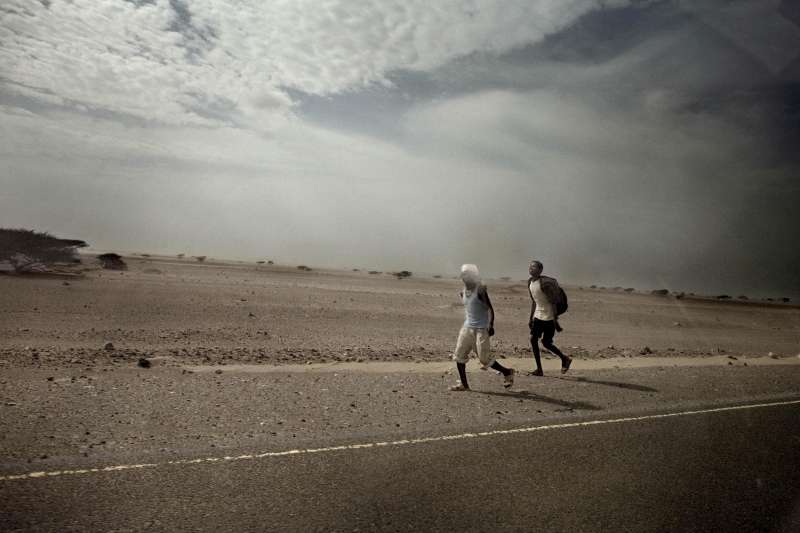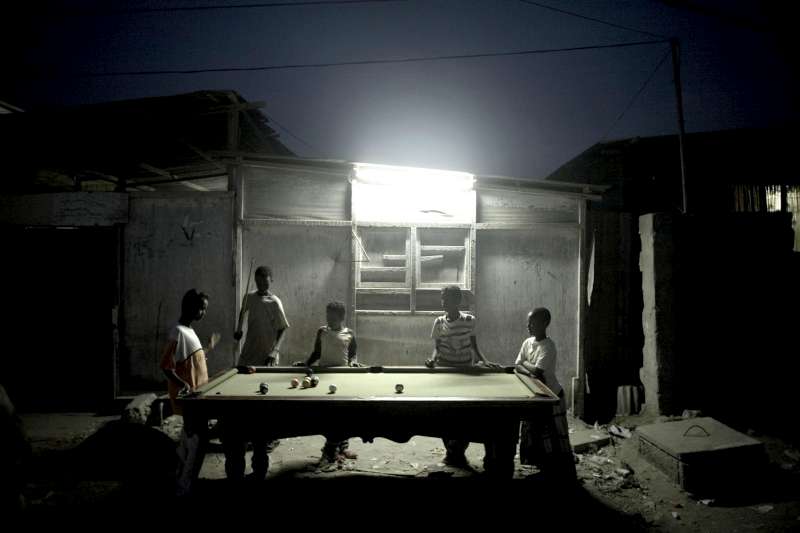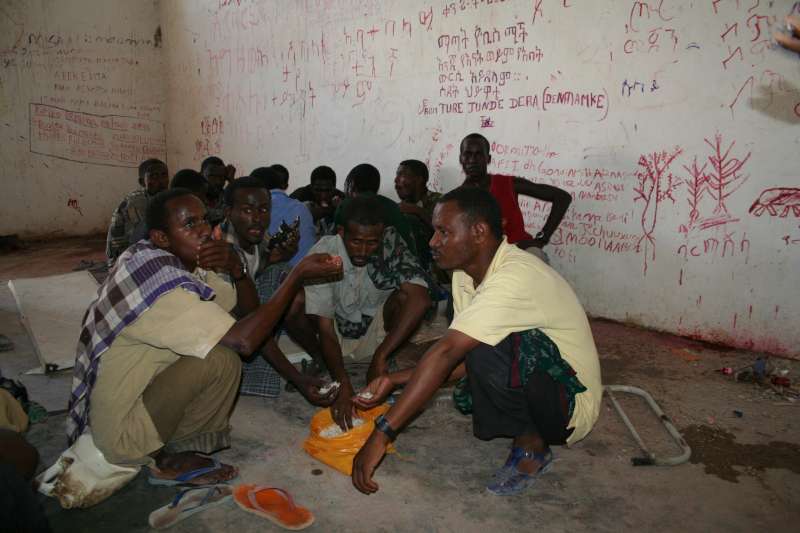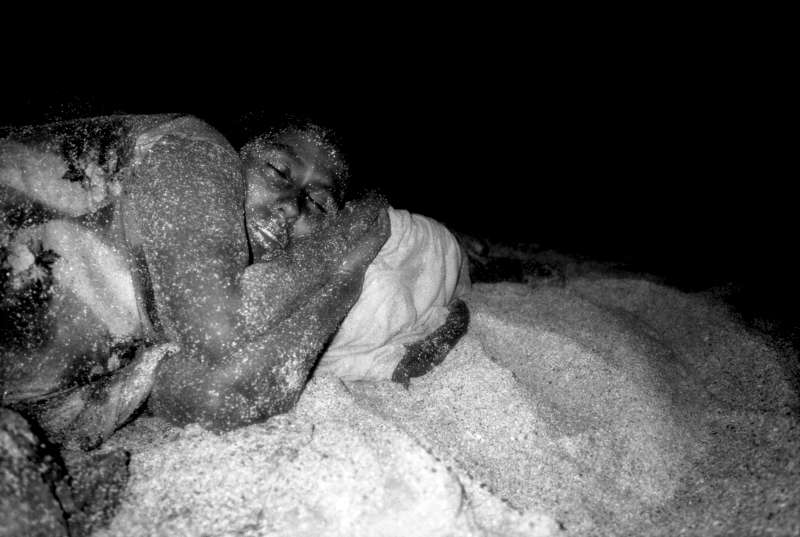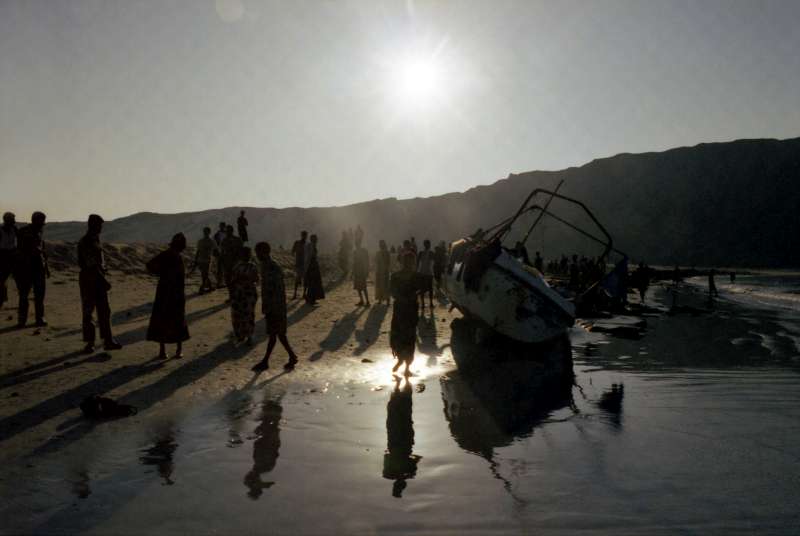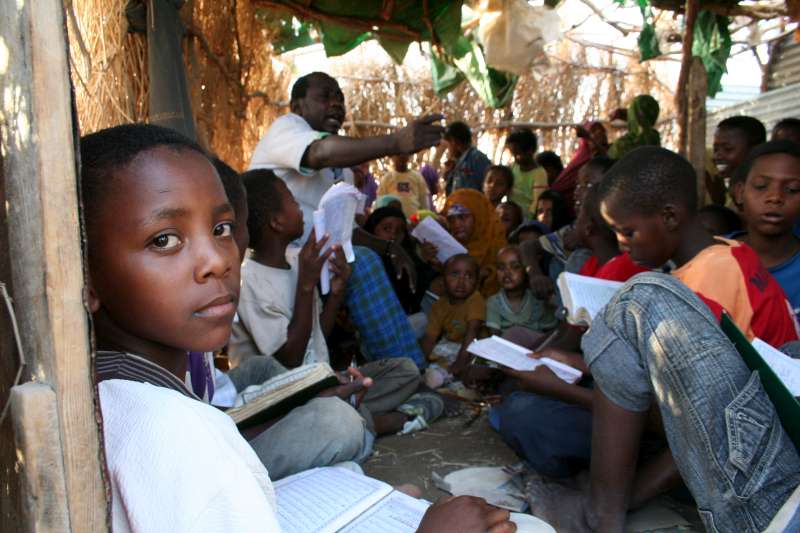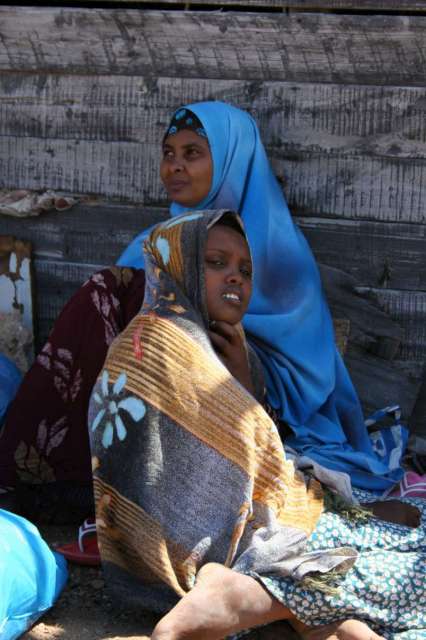By: UNHCR - Communications Group | 13 September 2011
| Français

The Society for Humanitarian Solidarity patrols 600 km of the Yemeni coast to help boat arrivals on the Gulf of Aden and Red Sea. © SHS
GENEVA, September 13 (UNHCR) - The UN refugee agency announced today that its annual Nansen Refugee Award will honour a Yemen-based non-governmental organization, the Society for Humanitarian Solidarity (SHS), for its life-saving work with refugees and migrants who make the treacherous sea journey to Yemen.
Every year thousands of refugees and migrants, desperate to escape violence, drought and poverty in the Horn of Africa, put their lives in the hands of human smugglers and cross the Red Sea and the Gulf of Aden in crowded and often unseaworthy boats. Some are beaten or abused, arriving traumatized and ill on the Yemeni coast.
So far in 2011, more than 60,000 people have made sea crossings to Yemen - as many as the combined number of arrivals in the last three years. It is estimated that at least 120 people drowned trying to make the journey this year.
SHS was founded by Nasser Salim Ali Al-Hamairy in 1995 to help people arriving by boat from Somalia and other parts of the Horn of Africa, as well as the impoverished local communities that hosted them. While the number of arrivals was low in the initial years, it has risen sharply 16 years later. In recent weeks, daily arrivals have averaged more than 300 people.
Today, SHS staff work around the clock to monitor about a third of Yemen's 2,000 kilometre-long coastline, pick up survivors, provide emergency care and, all too often, bury those who die en route.
"Thousands of refugees owe their survival to the people working for the Society for Humanitarian Solidarity," said UN High Commissioner for Refugees António Guterres, announcing the recipient of the Nansen Refugee Award in Geneva on Tuesday. "Their complete dedication to the service of mankind deserves this global recognition and support."
SHS founder Al-Hamairy, who is being honoured together with his staff of 290, said, "Winning the Nansen Award has given us a big boost. Our work is a humanitarian duty… that has to be done under any circumstance." He added that he would use the Nansen platform to call on the international community to "intensify efforts to improve the situation in Somalia to help dissuade people from attempting the risky crossing."
The Nansen Refugee Award is given annually to an individual or organization for outstanding work on behalf of refugees. It includes a $100,000 prize that the winner can donate to a cause of his or her choice. It was created in 1954 in honour of Fritdjof Nansen, a Norwegian, scientist, explorer and statesman and the first League of Nations High Commissioner for Refugees.
Previous winners include British photojournalist Alixandra Fazzina, US Senator Edward Kennedy, Japanese optometrist Akio Kanai and Italian opera singer Luciano Pavarotti.
This year's Nansen Award Ceremony will take place in Geneva on October 3.
Given to individuals or organizations for outstanding service in the cause of refugees.
-
One of a group of 38 newly-arrived refugees and migrants on a beach close to Hosaisha, Yemen. © Espen Rasmussen
-
A UNHCR truck transports new arrivals from Hosaisha to a reception centre where they will be registered and given food, water and medicine. © Espen Rasmussen
-
New arrivals inside the truck on their way to the reception centre. © Espen Rasmussen
-
Run by the UNHCR, the Mayfa'a reception centre is the first place the refugees get food and shelter after the dangerous journey across the Gulf of Aden. © Espen Rasmussen
-
A group of Somali refugees, who arrived in Yemen a couple of days ago, decide to walk from the Ahwar reception centre through the desert all the way to Aden. They prefer trying to make it on their own in Aden to living in a refugee camp. © Espen Rasmussen
-
Bottles, clothing and other items left behind by migrants and refugees outside Ahwar reception centre. © Espen Rasmussen
-
A UNHCR truck makes several stops along the coastal road to pick up new arrivals. © Espen Rasmussen
-
Somali refugees buy and sell fish in a small market in Kharaz refugee camp. © Espen Rasmussen
-
New arrivals in Kharaz refugee camp are given tents when they first arrive. If they stay longer, they are allocated a simple brick house inside the camp. © Espen Rasmussen
-
The walk to Aden takes several days. The desert heat is extreme, and often, travellers walk without any belongings and with insufficient drinking water. © Espen Rasmussen
-
In Aden, refugees and migrants end up in the poorest neighbourhoods, often with several family members living in a small room. There are not many jobs because of the high unemployment rate in Yemen. © Espen Rasmussen
-
Clothes belonging to migrants and refugees dry in the sun. © Espen Rasmussen
-
Somali refugees and migrants cross from Somaliland into the no-man's land between Somaliland and Djibouti. © UNHCR/J.Björgvinsson, March 2008
-
Staff from UNHCR and the Djibouti Refugee Commission talk with an exhausted Ethiopian man, who has travelled for days and gone without food or water in order to get to Djibouti. © UNHCR/J.Björgvinsson, March 2008
-
Marines patrol the Djibouti coast in an attempt to catch smugglers transporting refugees and migrants across the Gulf of Aden to Yemen. © UNHCR/J.Björgvinsson, March 2008
-
Two Yemeni smugglers caught and detained by marines as they were leaving the Djibouti coast on a boat loaded with refugees and migrants heading for Yemen. © UNHCR/J.Björgvinsson, March 2008
-
The entrance to the detention centre in the port of Obock. Once a jail, it houses Somalis and Ethiopians caught entering Djibouti before transfer. © UNHCR/J.Björgvinsson, March 2008
-
Somali and Ethiopian refugees and migrants wait in a room in the Obock detention centre. © UNHCR/J.Björgvinsson, March 2008
-
Detained Somalis and Ethiopians prepare a meal at the Obock detention centre. © UNHCR/J.Björgvinsson, March 2008
-
Migrants and refugees sit outside at the Obock detention centre, which was built to hold 20 detainees but now holds more than 200 people. © UNHCR/J.Björgvinsson, March 2008
-
A Somali family from Mogadishu wait outside the Djibouti Refugee Agency office, seeking to register as asylum seekers. © UNHCR/J.Björgvinsson, March 2008
-
Somalis and Ethiopians crowd outside the Djibouti Refugee Agency office in the capital, Djibouti. © UNHCR/J.Björgvinsson, March 2008
-
In Djibouti city, large numbers of refugees jam offices of the government department charged with the registration of asylum seekers. © UNHCR/J.Björgvinsson, March 2008
-
A group of women wait outside the Djibouti Refugee Agency office to register as asylum seekers. The wait could take days. Once registered, they are transferred to Ali Adeh, where UNHCR provides assistance. © UNHCR/J.Björgvinsson, March 2008
-
Refugees and migrants, including a baby, are picked up at a security post in the fishing village of Broom, Yemen by a UNHCR truck that will bring them to the Mayfa'a reception centre. © UNHCR/J.Björgvinsson, March 2008
-
After making the perilous journey across the Gulf of Aden, new arrivals are checked by a doctor at the Ahwar reception centre in Yemen. © UNHCR/J.Björgvinsson, March 2008
-
New arrivals at the Ahwar reception centre in Yemen. A surge in arrivals in 2008 was largely due to the conflict in Somalia and the use of new smuggling routes from Somalia to Yemen and from Djibouti. © UNHCR/J.Björgvinsson, March 2008
-
Women and children from a nearby camp for displaced people search a windswept beach near Bossaso for scraps of charcoal and driftwood to cook a meal. © UNHCR/A.Fazzina, 2007
-
A young girl crosses the barren wasteland to reach Shebele B camp on the edge of Bossaso. Once a thriving port, Bossaso is now surrounded by sprawling camps overflowing with displaced people from across the Horn of Africa. © UNHCR/A.Fazzina, 2007
-
A police patrol car makes its way along the Puntland coast road on the look out for arms and people smugglers. © UNHCR/A.Fazzina, 2007
-
Having fled violence in Mogadishu, displaced people call relatives from a call centre in Bossaso before attempting the perilous journey across the Gulf of Aden to Yemen. © UNHCR/A.Fazzina/2007
-
A smuggler lights a cigarette as he watches over a group of refugees at a safe house in Bossaso. The former fisherman was drawn to people smuggling by the money - he makes around $5,000 a month ferrying people across the Gulf of Aden. © UNHCR/A.Fazzina, 2007
-
Trying to keep warm, a woman from Addis Ababa joins a group of recently arrived Ethiopians and Somalis on a beach in Yemen. © UNHCR/A.Fazzina/2007
-
A dehydrated woman lies collapsed on a beach in Yemen after swimming to shore from a smuggler's boat. The perilous journey from Somalia took two days. © UNHCR/A.Fazzina/2007
-
Yemeni soldiers guard a group of Ethiopian refugees beside the tiny fishing boat that brought them across the Gulf of Aden from Somalia. © UNHCR/A.Fazzina, 2007
-
As day breaks, a man's body is washed onto the beach at Al-Bedha in Yemen by the incoming tide. © UNHCR/A.Fazzina, 2007
-
A row of corpses line Al-Bedha beach at dawn. Following the arrival of a group of 365 refugees by boat the previous night, 34 corpses were washed ashore - either beaten to death by smugglers or drowned offshore. © UNHCR/A.Fazzina, 2007
-
Gathered on Al-Bedha beach at dawn, Ethiopian refugees who arrived during the night lay out their clothes to dry on rocks. They were dumped by the smugglers nearly a kilometre from shore after being fired upon by Yemeni troops. © UNHCR/A.Fazzina/2007
-
Alongside the few meagre possessions that he has managed to salvage, a young boy breaks down in tears after searching for his missing brother all night. © UNHCR/A.Fazzina/2007
-
The body of a Somali woman washes up on the shores of South Yemen. In order to avoid detection, smugglers often force passengers off their boats and into the shark-infested waters far from shore. © UNHCR/J.Björgvinsson, March 2007
-
Newly arrived Somalis and Ethiopians rest on their smuggler's boat, which was forced ashore by the Yemeni armed forces. The smugglers escaped in a dinghy. © UNHCR/J.Björgvinsson, March 2007
-
Exhausted survivors of the Gulf of Aden crossing wait for help on a beach in Yemen. From the start of 2007 until late March, well over 100 deaths at the hands of people smugglers were recorded. © UNHCR/J.Björgvinsson, March 2007
-
Workers from a Yemeni non-governmental organisation hand out food before transporting newly arrived Somalis and Ethiopians to the Mayfa'a reception centre. © UNHCR/J.Björgvinsson, March 2007
-
Local Yemeni fishermen regularly recover and bury the bodies of Somalis and Ethiopians who drown after being forced to swim ashore by people smugglers. © UNHCR/J.Björgvinsson, March 2007
-
Graves line the beaches of South Yemen, serving as reminders of the thousands of men and woman who have perished at sea after fleeing misery and war in their homelands. © UNHCR/J.Björgvinsson, March 2007
-
Somali boat people seek shelter at the Mayfa'a reception centre in the south of Yemen. © UNHCR/J.Björgvinsson, March 2007
-
Victims of smugglers often require treatment for severe burns caused by exposure to sea water, motor oil, human waste and the sun during the sea crossing. © UNHCR/J.Björgvinsson, March 2007
-
A new arrival enjoys his first meal in three days at the Mayfa'a reception centre in Southern Yemen. © UNHCR/J.Björgvinsson, March 2007
-
A new arrival suffering from severe sunburn at the UNHCR clinic at the Mayfa'a reception centre. © UNHCR/J.Björgvinsson, March 2007
-
Packed into a truck, new arrivals leave the Mayfa'a reception centre for UNHCR's Kharaz refugee camp. © UNHCR/J.Björgvinsson, March 2007
-
Young Somalis and Ethiopians perch on a hill overlooking the part of the Kharaz refugee camp that houses new arrivals. © UNHCR/J.Björgvinsson, March 2007
-
Young students who crossed the Gulf of Aden take a break at the elementary school in Kharaz refugee camp. © UNHCR/J.Björgvinsson, March 2007
-
Grateful to have survived the perilous voyage across the Gulf of Aden, a mother embraces her four-month-old infant, who was born in South Yemen's Kharaz refugee camp. © UNHCR/J.Björgvinsson, March 2007
-
A crowded Koran class at the Kharaz refugee camp in South Yemen. © UNHCR/J.Björgvinsson, March 2007
-
Bossaso is not only the chief port of Puntland, a self-declared autonomous area in north-east Somalia, but also a major hub for people smuggling. © UNHCR/K.McKinsey, February 2006
-
For at least three years, thousands of Somalis, and increasingly, Ethiopians, have set off from the coastline in tiny open fishing boats hoping to reach Yemen. © UNHCR/K.McKinsey, February 2006
-
The government of Puntland says it needs international help to buy speedboats and to train policemen to better control widespread smuggling along its coastline. © UNHCR/K.McKinsey, February 2006
-
In the cliffs of Mareero, outside Bossaso, Somalis wait for the evening departure of the smuggler's boat they hope will take them to Yemen. © UNHCR/K.McKinsey, February 2006
-
A young mother waits for a boat with her two children. Her husband and two other children are waiting for them in Saudi Arabia. © UNHCR/K.McKinsey, February 2006
-
These people say they changed their mind about taking the trip across the Gulf of Aden when they saw how small and unsafe the boat was. © UNHCR/K.McKinsey, February 2006
-
A young Somali girl who survived eight days adrift at sea in a smuggler's boat recuperates on the floor of a large tent in Bossaso. © UNHCR/K.McKinsey, February 2006
-
Stunned survivors from a smuggler's boat who were rescued after eight days adrift in the Gulf of Aden. © UNHCR/K.McKinsey, February 2006
-
At dawn, Ethiopians arrive on the outskirts of Bossaso, Puntland's busy port, take off through the desert to evade a checkpoint and sneak into town in search of work or an illegal sea voyage. © UNHCR/K.McKinsey, February 2006
-
At feeding centres in Bossaso, Ethiopians who can't afford to go home or leave with people smugglers for Yemen, wait for the twice-daily food. © UNHCR/K.McKinsey, February 2006
-
Many Ethiopians, who ran out of money before they could get on smugglers' boats say the UNHCR/WFP food handouts are keeping them alive. © UNHCR/K.McKinsey, February 2006
-
The bodies of Somali and Ethiopian asylum seekers, who were forced to jump off of the traffickers' boat, washed ashore in Yemen. © SHS/N.Bajanoub, September 12, 2005












